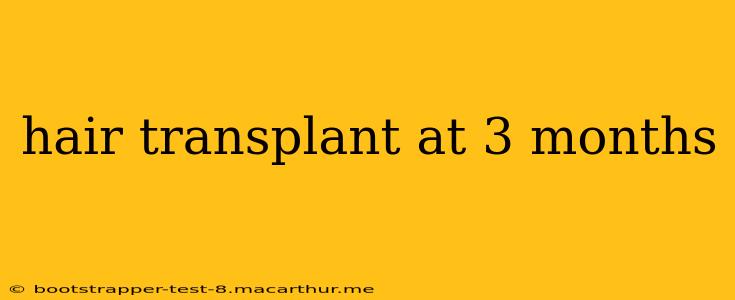A hair transplant is a significant investment, both financially and emotionally. At the three-month mark post-procedure, you're likely eager to see results. While the dramatic transformation isn't usually visible yet, this stage offers crucial insights into the healing process and the eventual outcome. This article will delve into what you can expect at three months post-hair transplant, addressing common questions and concerns.
What Does Hair Growth Look Like at 3 Months Post-Hair Transplant?
Three months post-transplant is still relatively early in the healing process. You might notice some subtle changes, but it's crucial to manage expectations. At this stage, many transplanted grafts might still be shedding, a process called shedding or shock loss. This is completely normal and doesn't indicate failure. The follicles are simply adjusting to their new environment. You might even see some initial growth, but it's usually fine and vellus-like (fuzzy and light), not the thick, terminal hairs you're ultimately aiming for.
Is it Normal to Still See Some Shedding at 3 Months?
Yes, shedding at three months post-transplant is perfectly normal. Don't panic if you continue to see some hair falling out. This is part of the natural hair growth cycle. The follicles need time to establish themselves before producing robust, noticeable growth. The shedding usually subsides around month 3-4, giving way to the gradual emergence of thicker, darker hairs.
When Will I See Significant Hair Growth After a Hair Transplant?
Significant, noticeable hair growth typically becomes visible around 6-9 months after a hair transplant. This is when the transplanted grafts start producing thicker, darker terminal hairs. However, it's essential to remember that the full results often take up to 12-18 months or even longer to fully manifest. Patience is key throughout this entire journey.
What Should I Do If I'm Not Seeing Any Growth at 3 Months?
If you're concerned about a lack of growth at three months, it's essential to avoid jumping to conclusions. Remember that shedding is a common occurrence. However, if you have significant concerns, consult your surgeon. They can assess your progress, address any potential issues, and provide personalized advice. Do not rely on online information as a substitute for professional medical consultation.
How Can I Optimize Hair Growth After 3 Months?
Following your surgeon's post-operative instructions is paramount. This typically includes:
- Maintaining a healthy lifestyle: Proper nutrition, sufficient hydration, and regular exercise support hair growth.
- Minimizing stress: Stress can negatively impact hair growth. Implementing stress-reducing techniques is beneficial.
- Using prescribed medications: Adhering to any medications or topical treatments prescribed by your surgeon is crucial.
- Gentle hair care: Avoid harsh chemicals, excessive heat styling, and tight hairstyles that can damage your hair.
- Follow-up appointments: Attending scheduled follow-up appointments with your surgeon ensures proper monitoring and addresses any concerns promptly.
What are the potential complications at 3 months post-hair transplant?
While rare, potential complications that might manifest around this time include infection (though usually much earlier), excessive scarring, or poor graft survival. Again, these are uncommon, but if you experience any unusual symptoms, contact your surgeon immediately.
Remember, patience and realistic expectations are crucial throughout the hair transplant process. The three-month mark is just one step in a longer journey. Regular communication with your surgeon, along with a healthy lifestyle, will significantly increase your chances of achieving optimal results.
